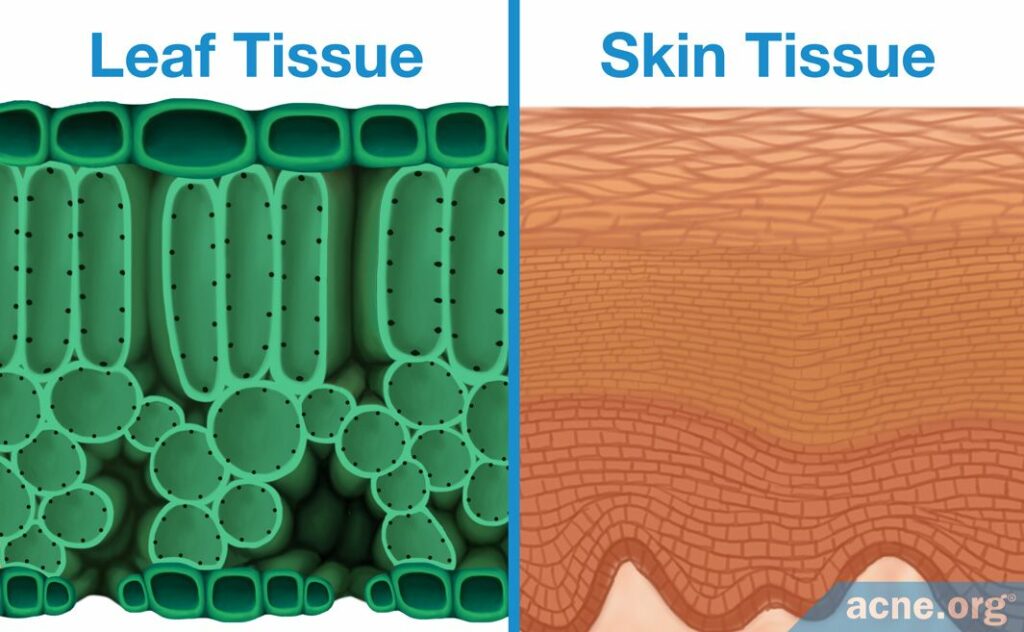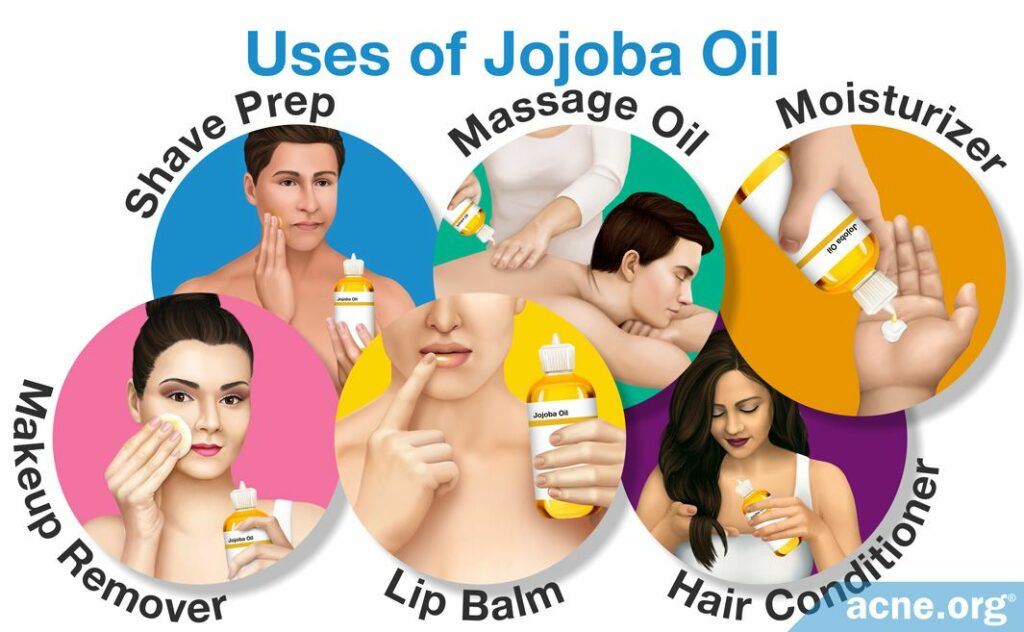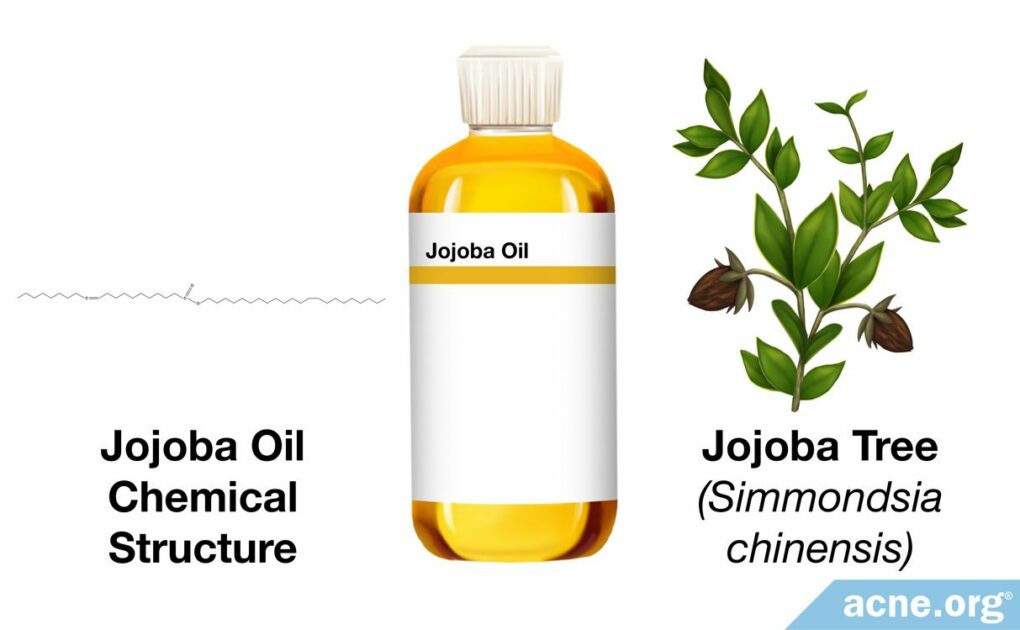Everything You Need to Know About Jojoba Oil

The Essential Info
Some oils, like coconut oil, are likely to clog pores and lead to acne. Other oils, like olive oil, are less likely to clog pores but are still not safe for acne-prone skin. And finally, some oils, like jojoba oil, will not clog pores and are safe to use if you have acne.
Unique properties of jojoba oil:
- It’s not chemically an “oil” like other oils: It is actually a wax ester with large molecules that do not enter pores.
- It’s extremely stable: As a wax ester, jojoba oil is exceedingly resistant to becoming rancid when compared with typical oils. Rancid oil should never be used on the skin.
- It spreads across the skin very well: This makes it a perfect massage oil and helps it simply “feel good” on the skin.
- It’s unscented: Truth be told, it has a very slight natural scent, but the smell is extraordinarily subtle, doesn’t bother anyone, and is actually quite nice.
- It’s hypoallergenic: Jojoba oil is kind to the skin and the body. It is the most chemically similar substance to human skin oil, and thus acts as a completely inert substance on the body. You can even use it fearlessly as an eye makeup remover.
- It’s environmental: Jojoba oil naturally grows in arid landscapes, which means it requires less oil than other crops.
Other Safe Oils: Sunflower oil and safflower oil are two other popular oils that are safe to use on acne-prone skin. They are not as stable as jojoba oil, and are not as good for some things as jojoba oil (massage for instance), but you can also use them without fear as long as you buy them fresh and never use them after they go rancid.

The Science
- What is Jojoba Oil?
- Benefits of Jojoba Oil
- Drawbacks of Jojoba Oil
- Uses of Jojoba Oil
- Can Jojoba Oil Help with Acne?
- Where to Buy Jojoba Oil
What is Jojoba Oil?
Jojoba (pronounced ho-HO–bah) oil is a botanical extract of the seed of the jojoba tree (Simmondsia chinensis). Technically it is not actually an oil, but rather what is called a wax ester. Why do we care? Because out of all of the compounds in nature, this wax ester is the most similar to human skin oil (sebum). It is theorized that applying jojoba to the skin can “trick” the skin into thinking it is producing enough oil, thus balancing oil production. The bottom line for acne-prone people is that jojoba oil is non-comedogenic so you can use it without fear.

Leaf Tissue
The waxy cuticle of a leaf keeps moisture inside the leaf. Its array of epicuticular wax esters is chemically similar to jojoba wax esters.
Skin Tissue
The outermost layer of the skin, called the stratum corneum, keeps moisture inside the skin. Its array of epidermal wax esters is chemically similar to leaf wax esters.
Benefits of Jojoba Oil

- Because jojoba oil doesn’t evaporate, it provides all-day moisturization.
- It is theorized, but not yet proven, that because jojoba oil is so similar to human skin oil, it can “trick” the skin into thinking it has produced enough oil and thus balance oil production.
- Jojoba oil does not become rancid or lose antioxidants even after long periods of storage. Just make sure to store in a cool, dry place. Jojoba oil can grow mold if stored in hot, high-humidity environments, like the shower.
- Jojoba oil spreads well on the skin, absorbs nicely, and has a friendly, “inert” feel to it.
Drawbacks of Jojoba Oil
- At high amounts (over 4 drops) it can impart a shine to the skin when using it on the face. For this reason, it’s best to keep it at or below 2-3 drops if you’re applying it during the day. At night before bed, feel free to use as much as you like.
Uses of Jojoba Oil
- Moisturizer: After dispensing any facial moisturizer onto your palm, add up to 2-3 drops of jojoba oil to make it into a super-moisturizer. Flakiness will subside and the moisturizer will have an improved feel on your skin.
- Makeup remover: Since jojoba oil is not an eye irritant, nor allergenic, you can use it to remove eye makeup. It also easily removes foundation, blush, and lipstick.
- Lip balm: Apply a few drops onto your finger and apply to your lips for an extra-light alternative to lip balm. Lots of lip balms tend to contain comedogenic (clogs pores) ingredients, so jojoba oil is a nice alternative. As a side note, if you need major help with dry lips, Vaseline® (pure petroleum jelly) or Aquaphor® (petroleum jelly + mineral oil, ceresin, and lanolin alcohol) are non-comedogenic, inexpensive, and work very well.
- Hair conditioner: You can mix a few drops of jojoba oil into your current conditioner or use jojoba oil on its own in the shower. Just remember, don’t store jojoba oil in the shower. Store it in a cool, dry place. You can also add it to damp hair before drying. Also, you can add it to dry hair to promote shine. Jojoba oil also moisturizes the scalp, helping prevent dandruff.
- Shave prep: For men, put 8-10 drops or more of jojoba oil on your beard area beneath your shaving cream (lather from your cleanser or other non-comedogenic shaving cream) for a more comfortable shave. This helps prevent razor burn and leaves your skin feeling nice and soft.
- Massage oil: Jojoba oil is, in my experience, by far the best massage oil on earth, and if I ever get a massage I always take some jojoba oil along and ask them to use it instead of whatever massage oil they have. Not only is it a great massage oil, there’s no fear of it leading to body acne. However, it’s important to remember that physical irritation, which can come with massage, may still promote breakouts.
Can Jojoba Oil Help with Acne?
In the 1980s, scientists speculated that jojoba wax might be useful for treating acne and psoriasis based on some preliminary observations.1 More than two decades later, one study came out showing some very weak evidence that jojoba oil might help with acne. Just one study is not enough for us to draw conclusions, and this study in particular is not convincing, so we would need to see more research testing whether jojoba really improves acne to a significant degree.
This one study performed so far tested jojoba oil on people with mild acne. That study found that 6 weeks of applying a jojoba-oil-containing clay facial mask 2-3 times a week reduced acne lesions by about half.2 However, much of the anti-acne effect may have been due to the clay in the mask rather than jojoba itself, so it’s a bit tough to say what led to the reduction in acne.
Expand to read details of study

The study was published in the German journal Research in Complementary Medicine in 2012. In the study, 194 people with mild acne applied a clay-based mask containing jojoba oil to the face 2-3 times a week for 6 weeks. The researchers found that after 6 weeks, the total number of acne lesions had decreased by 54% on average. The scientists wrote, “The present study gives preliminary evidence that healing clay jojoba oil facial masks can be [an] effective treatment for lesioned skin and mild acne vulgaris.”2
However, the scientists noted that clay might also have contributed to the anti-acne effect. We should also keep in mind that in this study, questionnaires were used to collect the data. In other words, rather than directly evaluating the participants’ acne, the researchers asked the participants to count their own acne lesions and to fill out questionnaires. This makes the data less reliable.
Even though this is only one preliminary study, there is still reason to be cautiously optimistic about jojoba oil for acne. Research suggests that it may have anti-inflammatory properties. Since acne is fundamentally an inflammatory disease, anything that fights inflammation could be helpful in reducing acne. In addition, jojoba may help restore the skin barrier (the outer layer of skin), which is important to keep strong when you are acne-prone.3,4
Our Partner Farm

When I was looking for an organic jojoba oil producer, I wanted only the best. I looked at a few companies from the USA and one from Israel. I settled on the world’s first jojoba supplier to offer certified organic jojoba oil. This means they have the most experience and the most mature organic trees. After speaking with their quality control department, I also felt comfortable with their manufacturing procedures. For instance, they harvest only clean, dry, tree-ripened seeds, employ strict moisture and temperature control procedures, and finish up with cool single press extraction. I’ve learned that these steps result in the purest possible, unrefined oil. They are one of the world’s largest jojoba oil producers. Each year they harvest a large crop of jojoba nuts from the more than 750,000 mature jojoba trees growing at their 2000 acre farm. Currently they have over 600 acres of certified organic jojoba trees, where 100% of our oil comes from. They control the entire process, from growing the trees and harvesting the seed to processing the jojoba oil. This is good because it keeps outside variables to a minimum and assures us of a dependable supply that we can trust.
Also, I always inquire about our manufacturer’s environmental policies. Our partner farm says they are mindful to reduce waste, recycle, and conserve. Furthermore, jojoba growth helps sustain farming in rural communities and helps save precious desert water. Their farm, located in the desert, encourages jojoba’s natural growth with a minimum of external input. They also adhere to strict EPA, Organic and OSHA standards that protect us, the farmers, and the product.”
Dan Kern, Acne.org founder
Where to Buy Jojoba Oil
Our store – You guys asked me to start selling it, so I now sell organic jojoba oil in a giant 8 oz. size for about half the price per ounce of organic jojoba oil on store shelves.
Health food stores – You can find jojoba oil at almost any health food store. I always see it myself at Whole Foods®. Basically, it’s widely available. Just make sure to check the label if you want organic.
Acne.org Organic Jojoba Oil (8 oz.) retails for $17.21
References
- Gad, H. A., Roberts, A., Hamzi, S. H., Gad, H. A., Touiss, I., Altyar, A. E., Kensara, O. A. & Ashour, M. L. Jojoba oil: An updated comprehensive review on chemistry, pharmaceutical uses, and toxicity. Polymers (Basel). 13, 1711 – 1733 (2021). https://pubmed.ncbi.nlm.nih.gov/34073772/
- Meier, L., Stange, R., Michalsen, A. & Uehleke, B. Clay jojoba oil facial mask for lesioned skin and mild acne–results of a prospective, observational pilot study. Forsch Komplementmed. 19, 75-79 (2012). https://pubmed.ncbi.nlm.nih.gov/22585103/
- Lin, T. K., Zhong, L. & Santiago, J. L. Anti-inflammatory and skin barrier repair effects of topical application of some plant oils. Int J Mol Sci. 19, 70 (2017). https://pubmed.ncbi.nlm.nih.gov/29280987/
- Al-Obaidi, J. R., Halabi, M. F., AlKhalifah, N. S., Asanar, S., Al-Soqeer, A. A. & Attia, M. F. A review on plant importance, biotechnological aspects, and cultivation challenges of jojoba plant. Biol Res. 50, 25 (2017). https://pubmed.ncbi.nlm.nih.gov/28838321/
 Acne.org Products
Acne.org Products